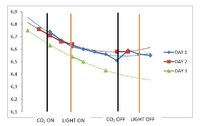Ok, so I increased the bubble rate to 1 bps yesterday night and the injection of CO2 began two hours before lights went on this morning...
And the result is a change from green (probably dark green) to lime green in my DC that remained quite stable from lights on until now (some minutes to CO2 shut off and 2 hours to lights off). My pH reading indicates that there has been only a drop of 0.5, from 6.92 to 6.41
So my DC says "it is not bad", but the pH readings say "it could be better".
So, what do you think about it? Should I try to place the ceramic diffuser under the inflow to see if I can manage to have a more relevant pH drop (and probably a yellowish in my DC)? At least this would be a way to know where the limit (no fish on tank).
And the result is a change from green (probably dark green) to lime green in my DC that remained quite stable from lights on until now (some minutes to CO2 shut off and 2 hours to lights off). My pH reading indicates that there has been only a drop of 0.5, from 6.92 to 6.41
So my DC says "it is not bad", but the pH readings say "it could be better".
So, what do you think about it? Should I try to place the ceramic diffuser under the inflow to see if I can manage to have a more relevant pH drop (and probably a yellowish in my DC)? At least this would be a way to know where the limit (no fish on tank).







